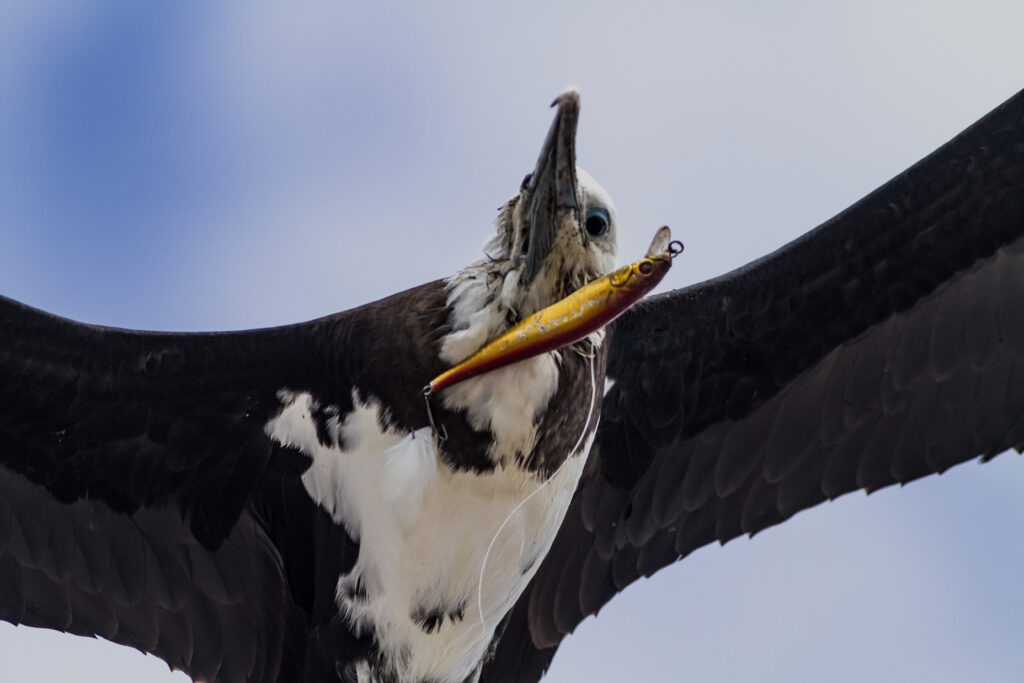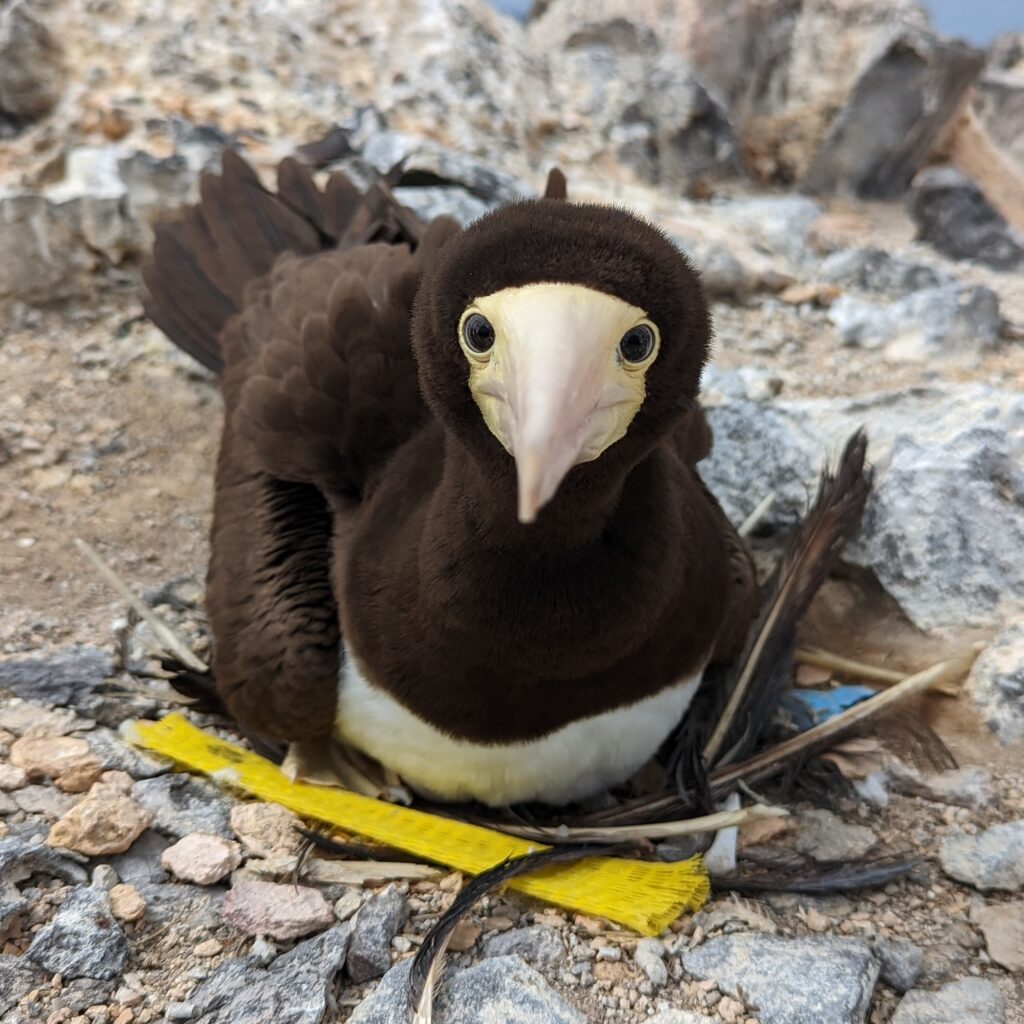Co-authored by Alex McGoran and Laura Shearer.

What is the typical diet of most seabirds? You’d expect a smorgasbord of marine life such as fish, squid and krill. Unfortunately, plastic debris is becoming an increasingly common component of seabird diets globally.
With a total area of 91 km2, Ascension Island has an ecological significance that far outweighs its size. This tiny volcanic outcrop is the most important seabird breeding site in the tropical Atlantic; supporting 11 species of breeding seabird, including the endemic Ascension Island frigatebird. Therefore, the potential impact of plastic pollution is a serious concern.
In a pioneering study, Blue Belt Programme colleagues in the Cefas Marine Litter team are investigating seabird stomachs from Ascension Island for plastic pollution. Specifically, they are looking for mesoplastics (items larger than 2.5 cm) and microplastics (sizes ranging from 1 μm to 5 mm). Through this study, scientists will gain valuable insight into the plastic problem and support future work to protect its seabird population.
Evidence of Plastic in Ascension’s Seabirds
The team investigated samples taken from frigatebirds, boobies, terns and a tropicbird. As expected, flying fish (Exoceoetids), squid beaks, and turtle hatchlings have been recovered from the samples so far. Unfortunately, we have also found evidence of plastic.
85% of the birds investigated as part of this study had microplastics and litter within their stomachs. Of this, microplastics made up 11% of all non-natural debris within this study. Nine different plastics were identified in the samples, with polypropylene and polyethylene being most common. These are the most highly manufactured plastics globally due their wide use in packaging. Other plastics included polyethylene terephthalate (PET) whihc is used in plastic water bottles and acrylic.
The most common litter was cellulose-based items accounting for 31% of litter retrieved within the study. A range of materials are made from cellulose. Some are natural like plant material, some are man-made but natural like cotton, and some are so chemically treated that they are known as semi-synthetic. These are generally rayon, viscose and lycocell (synthetic silks).
Under the Convention for the Protection of the Marine Environment of the North-East Atlantic (OSPAR Convention), semi-synthetic materials like rayon are classed as plastic. Cellulosic items are generally the most common litter found in many environments around the world. Some studies have suggested that they can last as long as plastic and be equally harmful to wildlife. However, more research is needed to imporve our understanding.
The Problem with Plastic Pollution
The entirety of Ascension Island’s territorial waters is encompassed by its marine protected area (MPA). It is the 8th largest in the world, protecting a total of 443,571 square kilometres (171,264 sq mi). Within its limits, commercial fishing and mineral extraction are prohibited, making the MPA a sanctuary for marine life. However, the protective abilities of the MPA are limited when it comes to plastic.
Much of the ocean plastic within Ascension’s MPA originates from far beyond its territorial waters. Analysis of 286 plastic bottles carried out by the South Atlantic Plastics Project, found that 92% of identifiable bottles originated from China. Additionally, hotspots have been identified on the southern coast of the island where plastic has been transported by ocean currents and accumulated there.

Behavioural interactions with plastic have already been observed on Ascension Island. Brown boobies Sula leucogaster are known to use plastic to line their nests. Frigatebirds have also been seen ‘playing’ with plastic items, picking them up and dropping them to recollect mid-air or off the surface of the ocean. They do this to practise fishing techniques or stealing food from other seabirds in mid-air in a behaviour known as kleptoparasitism. Through this study, the Ascension Island Government is hoping to understand if these seabirds are also ingesting plastic items and possibly to what extent.
Plastic pollution poses a significant threat to marine life. Seabirds, like many other ocean-dwelling creatures, often mistake plastic items for food. In some families,100% of species ingest plastic and are highly susceptible to this form of pollution. Sadly, some albatross chicks have been found with stomachs full of plastic fed to them by their parents.
Items such as plastic bags, bottle caps, fragments of packaging, and synthetic filaments can end up in seabird stomachs, leading to physical harm. The plastic doesn't break down easily, so it can accumulate, causing blockages or internal injuries. In some cases, ingested plastics can lead to malnutrition or even death, as the birds feel satiated without receiving the necessary nutrients from actual food.
Why are dissections necessary?
Dissections are a vital tool in understanding the dietary habits and ecological roles of marine birds. Researchers analyse seabird stomach contents to gather valuable data about their feeding behaviours, migration patterns, and even environmental health. The findings offer valuable insight into the health of ocean ecosystems and the impact of pollution on wildlife.
For this particular study, the Cefas Marine Litter team are investigating sixty seabird stomachs from six species. Collected between 2016 and 2023, these samples are comprised of birds that unfortunately collided with local wind turbines or died of other causes.
Our team’s work follows an extended version of the OSPAR Convention monitoring guidance for Northern fulmars (Fulmarus glacialis). Under the OSPAR convention, fulmar stomachs are used as an indicator for mesoplastic pollution on the sea surface. Fulmars are abundant and widespread seabirds known to regularly ingest litter. By following the OSPAR protocols, we’re ensuring that this study can be compared to others in the North Atlantic.
Cleaning up Ascension Island’s Coast
The Ascension Island Government are already taking positive action to tackle plastic pollution through improved waste management procedures on the island. In an ongoing commitment to reduce reliance on single-use plastics, the Ascension Island Council recently agreed to recommend changes in legislation to stop the importation of single-use vapes. A big win for a small island!
Additionally, the Ascension Island Government Conservation Directorate increase awareness of the impacts of litter through community outreach and regularly performs beach cleans. New beach cleaning stations will be installed at key beach nature reserves around the island to support the initiative.
The findings of this study will aid the Zoological Society of London’s South Atlantic Plastics Project in understanding plastic's impact on Ascension's seabirds. The project examines plastic pollution on Ascension and St Helena. Data provided by the study can also support lobbying efforts to influence local policies and reduce plastic to protect wildlife.
Developing Global Networks
This study is just a small part of the exciting and impactful international work being conducted as part of the Blue Belt Programme. We work closely with UK Overseas Territories to assist them in creating and maintaining healthy and productive ecosystems.
From building expertise to scientific studies to innovations in enforcement, sign up for our newsletter and stay updated with the latest from the Blue Belt Programme.
Leave a comment